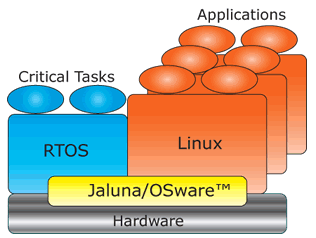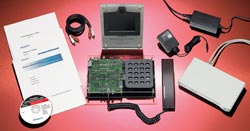Jaluna rev’s virtual platform for single-core TI DSPs
Sep 6, 2005 — by LinuxDevices Staff — from the LinuxDevices Archive — 6 views Jaluna has updated its platform virtualization product, adding features aimed at engineers building media-processing devices. OSware, Linux Edition for TI DSP v1.2 features support for C++ applications, among other new features, and is being used by customers to build IP-STBs and IP-videophones, the company says.
Jaluna has updated its platform virtualization product, adding features aimed at engineers building media-processing devices. OSware, Linux Edition for TI DSP v1.2 features support for C++ applications, among other new features, and is being used by customers to build IP-STBs and IP-videophones, the company says.
OSware includes an “NK2” nanokernel, said to divide hardware resources among multiple operating environments while preserving the real-time capabilities of each. It also provides a virtual bus for interOS communication and an optional software watchdog component.

OSware enables multiple application environments, including Linux, to share a single processor, including a single DSP
Jaluna first shipped OSWare for TI's single-core DM64x/C64xx series in September of 2004, saying the technology allowed uClinux to run alongside the chips' native “DSP/BIOS” real-time signal processing environment. This capability enables device designers to save 20 to 25 percent on BOM costs for a typical $100 device, the company says, by eliminating redundant parts and simplifying hardware logic, while also minimizing device footprint. The product was adopted by Amino, it announced in June, for use in tiny, inexpensive STBs barely larger than their own remote controls.
According to Jaluna's executive VP of corporate development, Michel Gien, key improvements to OSWare for TI DSPs include better streaming support thanks to new RTP/RTSP protocol libraries, the ability to share a single Ethernet hardware interface between DSP-BIOS applications and Linux applications, and support for C++ (ISO 98) applications. Other new features include the ability to share a single physical serial port between environments, support for Linux kernel modules (including proprietary enhancements and device drivers), and compatibility with the latest version (v3.1) of TI's Code Composer Studio tools.
In addition to updates, Jaluna announced two new customers of OSWare Linux Edition for TI DSPs. Chinese video communications specialist Wintech Digital Systems Technology will use the product in its IP-videophone reference designs and development tools. Meanwhile, in Spain, SIDSA will use OSWare to create IP multimedia STBs based on Linux and DSP/BIOS.
Wintec's videophone reference design
 According to Jaluna, Wintech adopted OSWare in order to add support for “prevailing Linux applications” to its broadband videophone designs and development tools. Use of OSWare allowed Wintech to preserve its investment in DSP/BIOS applications, while adding Linux-based Web browsers, email clients, games, and MP3 players to its Videophone Development Platform (VDP, pictured at right), Jaluna says.
According to Jaluna, Wintech adopted OSWare in order to add support for “prevailing Linux applications” to its broadband videophone designs and development tools. Use of OSWare allowed Wintech to preserve its investment in DSP/BIOS applications, while adding Linux-based Web browsers, email clients, games, and MP3 players to its Videophone Development Platform (VDP, pictured at right), Jaluna says.
Wintech describes VDP as an integrated hardware/software development platform, and claims it is the only available single-core DSP design to support CIF-resolution (288 x 352) H.264 video. VDP is based on TI's DM643 DSP.
According to Jaluna, the personal videoconferencing market is expected to jump from $21M in 2003 to $180M in 2008.
Wintech will demonstrate its VDP product at the Embedded Systems Conference next week in Boston.
SIDSA's IP-STBs
Another new customer of Jaluna's OSWare Linux Edition for TI DSPs is SIDSA, which will use the product in a new IP-STB design. SIDSA is a Spanish provider of multimedia conditional access solutions (CAS), digital televisions (DTVs), and DSL broadband communications equipment.
Gien said, “The feedback we're getting is that our partnership with TI is working well. Using DSP/BIOS for codecs, and having a Linux personality at the same time, avoids the need for an application processor. This single-core architecture is ideal for mid-range, high-volume devices.”
Gien adds, “We're also getting a lot of traction in the in-flight entertainment market, and we will have one very big announcement in the mobile phones market sometime after 3GSM next February in Barcelona.”
Long term plans for OSWare
Asked how long Jaluna expects the market to last for products aimed at helping companies transition to Linux, Gien stated, “We're not too concerned, because we think migration will take much longer than anyone thinks — 10 years, easily. Lots of people are investing in the fact that we can keep the life of legacy software longer. If we can increase their return-on-investment, they feel really good about it.”
Gien adds that he also envisions OSWare virtualization technology gaining increasing importance as a management and security layer similar to the TrustedCore pre-boot software environment marketed by BIOS vendor Phoenix.
Gien stated, “OSWare will remain important for two reasons. First, you have multicore, complex hardware to support — the same level of complexity as what you find in servers. Two, is security threats once you start running Windows or Linux or any open OS. For example, whenever Linux gets improved in security, you need outside management functions in case the new kernel gets corrupted [during a firmware upgrade].”
Gien continues, “OSWare can be used to build an OS-independent management layer for upgrades, configuration, and in the future, security. In addition to a pre-boot layer, it can provide an API that you could use to run a watchdog, or other control or monitoring software. You can essentially turn the CPU into a DSP that controls the whole system.”
Gien continues, “Operating systems are frozen beasts. OSWare is a way to get to some new ways of building system architecture. You can leverage OSes as they are, and start to build some other system functions around it, by using a pre-boot hypervisor, middleware, whatever you want to call it.”
Availability
OSWare Linux Edition for TI DSPs v1.4 is shipping now.
A Windows version of OSWare also exists, but is not “on a real business track yet,” according to Gien. “Most of our action today is around Linux, but we are asked more and more about Windows. There is a lot of interest in the mobile phone area. We have a prototype, and may be able to do a real phone soon. Perhaps we'll be able to show something at 3GSM.”
Gien adds, “We'd like to have a Symbian option, but they don't like us, because we want to give customers a choice not to use Symbian.”
A Linux version supporting Nucleus is also available.
This article was originally published on LinuxDevices.com and has been donated to the open source community by QuinStreet Inc. Please visit LinuxToday.com for up-to-date news and articles about Linux and open source.